Cricket ranks as one of the most popular sports on a global scale, boasting a substantial fanbase in Australia, Great Britain, Pakistan, South Africa, and India. The International Cricket Council (ICC) governs the sport and has more than a hundred members worldwide. Cricket ranks second in popularity right behind soccer, with a fanbase of more than 2.5 billion people from over 180 countries.
In 2019, the Men’s Cricket World Cup became the most-watched ICC event in history with an audience surpassing 1.6 billion people, which further demonstrates the impressive reach of this bat-and-ball game. Many cricket fans are looking to increase their involvement in the sport by betting on events from major international and domestic competitions.
The ICC Cricket World Cup, the Indian Premier League (IPL), the Ashes, the Hundred, and the T20 World Cup tend to attract the most betting action. One of the great things about cricket is that punters can still bet on it even if they are not experts on the sport. Similarly to baseball, cricket is all about statistics. Punters with rudimentary knowledge have access to tons of reliable stats that improve their chances of making informed bets.
Given the immense popularity of this bat-and-ball sport, it is unsurprising cricket has become a staple at online betting sites. There is no shortage of cricket action at online sportsbooks, with punters having a choice from various tournaments and bet types. Cricket organizers have introduced different cricket formats as the sport evolved, further increasing cricket’s appeal and the betting opportunities it offers.
In the following guide, Super Betting Sites will lay out the rules of cricket, tackle the different cricket formats, and explain how cricket odds work. Stick with us till the end for some useful strategy tips that can boost your odds of becoming a successful cricket bettor.
Basic Rules of Cricket
It would be ludicrous to think you can successfully punt on a sport when lacking adequate knowledge of its rules. Cricket rules often seem overly complicated to novices so we shall explain them in brief to give novices a better idea of how the sport works. Cricket is a bat-and-ball sport played on an oval pitch with two wickets, one on each end.
A cricket team consists of eleven on-field players, including a captain, batters, and bowlers. A coin is tossed to determine which team will bat in the first innings. The batting team will then send two batters, one positioned in front of each wicket. The members of the bowling team spread out on the pitch. The bowling team then throws the ball at a batter.
The goal of the batters is to score as many runs (points) as possible before the end of the innings. The batters are running past each other, from wicket to wicket, while the ball is in play. There are two ways for an innings to end – the bowling team must either finish their number of balls, or eliminate ten of the eleven batters of the batting team.
A batter is out when a member of the bowling team catches the ball before it falls to the ground or if the ball hits the wicket and dislodges it. Dislodging can also occur when the batter steps farther from the wicket, fails to hit the ball, and a member of the rival team knocks down the bails.
Finally, a bowling team can hit the wicket stumps with the ball before a batter manages to reach it. The eliminated batter then withdraws from the field and another member of the batting team replaces them. The two teams switch their roles for the second innings. The bowling team becomes the batting team and attempts to score more runs than the competition.
Exploring International Formats in Cricket
Familiarizing yourself with the different formats in this bat-and-ball sport is essential if you want to become successful at cricket betting. While the game’s objective is always to outscore the opponents, the precise rules and regulations vary across different cricket formats. It is important to understand the fine nuances of each format before you start with your cricket punts. There are several clearly defined international formats, including test cricket, one-day internationals, and T20 (Twenty20).
Test Cricket
Dating back to 1877, this is the oldest cricket format where a match can run for up to five days and is considered the ultimate test of players’ physical endurance and capabilities, hence the name. Each match consists of four innings, two batting ones and two bowling ones. One of the most distinctive traits of test cricket is that it has no specific limit on the maximum number of overs. An over occurs when no runs are scored.
The minimum number of overs required is set at 90 per day. The format comprises three two-hour sessions. Players take breaks between the sessions – 40 minutes as a lunch break and 20 minutes for a tea break. The duration of the sessions and the breaks between them may sometimes vary depending on the circumstances. A standard test match can end in one of three ways – a win for one of the two sides involved, a draw, or a tie.
Perhaps you are wondering what the difference between a draw and a tie is. In test cricket, the team that bats first emerges a winner whenever it scores more runs than the opponents while preserving all of its wickets. The team batting first can also win provided it outscores the competition while taking all ten of its wickets. A draw occurs whenever the first batting team scores more runs than the opposition without taking all of its wickets. Respectively, the team that bats last wins if it outscores the other side while preserving all of its wickets.
The two competing teams tie whenever the last side to bat loses its ten wickets but the overall number of scored runs is the same for both sides. The tie is an extremely rare occurrence in test cricket. Over 2,000 tests have taken place since the format first emerged in the late 1870s. Only two of them have ended in ties, however. The teams participating in test cricket play in the traditional white uniform kits as opposed to the colored kits worn in Twenty20 cricket and one-day internationals.
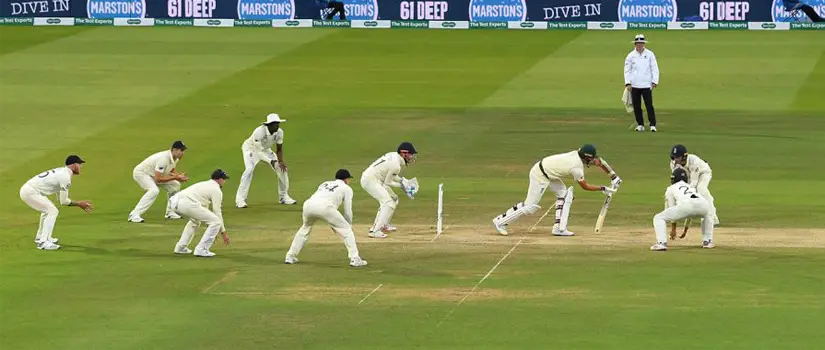
One-Day Internationals
As the name suggests, one-day internationals (ODI) end within a single day unless the weather is poor. The format dates back to the early 1970s and involves two competing teams of eleven players each. The maximum number of overs allowed per side is fifty, with one break between the innings. Again, a side wins provided it outscores the opponents.
The simplicity of this format makes it easier to understand, which is why it attracts a greater audience of viewers and bettors. Things get slightly more complex whenever the two sides score the same number of runs when the game ends. In most such cases the clash ends in a tie but there is a “super over” in some instances. Each participating team gets six extra balls to determine the clear winner.

T20 Cricket
The T20 (short for Twenty20) is probably the most exciting format in international cricket. It emerged in 2005, allowing for up to twenty overs per innings for each side involved. The goal is to complete the twenty overs within eighty minutes to outscore the rival team. Such games usually continue for approximately three hours and there is a short fifteen-minute break between the innings.
Most of the other rules coincide with those for the one-day internationals. The Twenty20 family is broader than those in the other formats since the International Cricket Council decided to give permanent T20 status to all its country members in 2019. The ultimate purpose of all those members is to participate in the T20 International World Cup, which started back in 2007.
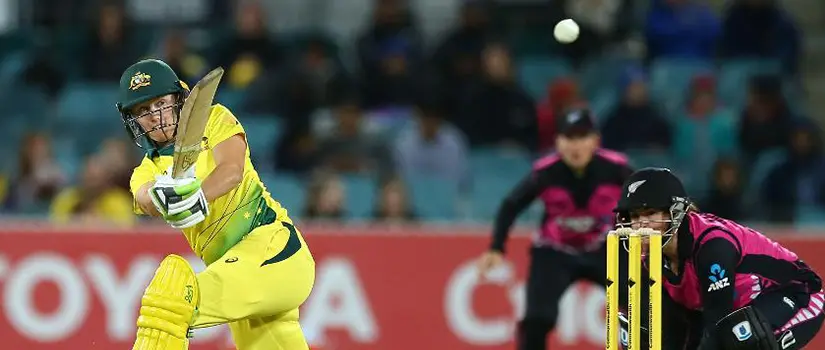
Understanding Cricket Odds
The odds formats bookmakers use for cricket are no different than those for all other sports. The format for the odds expression largely depends on the targeted market(s) the sportsbook services. Betting sites that target primarily punters from the United Kingdom and Australia tend to price their cricket markets using fractions.
Indian cricket fans commonly prefer the decimal format of odds expression while the moneyline is prevalent at the other side of the ocean in the United States and Canada. You can check the table below to better comprehend how cricket odds in different formats work. The example we give is with a three-way bet for a hypothetical women’s test match between Australia and India.
| Understanding the Different Formats of Odds Expression for Cricket | |||
|---|---|---|---|
| Outcome | Fractions | Decimals | Moneyline (US odds) |
| Australia to Win (W) | 15/2 | 8.50 | 750 |
| India to Win (W) | 9/1 | 10.00 | 900 |
| Draw (W) | 1/6 | 1.17 | -590 |
So if a sportsbook prices Australia to prevail over India at decimal odds of 8.50, this means the oddsmakers estimate the Aussies winning chances are approximately 12%. They price India at 10.00, which gives the Indian ladies roughly 10% probability of winning. The oddsmakers price the draw at decimal odds of 1.17, meaning this is the most probable outcome with around an 85% chance of occurrence.
To proceed with the example, we shall suppose you decide to back the draw with a $100 wager. If the game indeed ends in a draw, your $100 bet will earn you a total payout of $100 x 1.17 = $117. In short, you will walk away with a net profit of 100 x (1.17 – 1) = 100 x 0.17 = $17 after your bet settles.
Some people find math and calculations slightly intimidating but you should not worry if you are one of them. All good online sportsbooks use advanced software that calculates the potential payouts of the wagers as soon as punters add them to their betslips.
As for the odds formats, the online bookies normally allow you to switch between the three most common options (decimals, fractions, and moneyline), depending on your personal preferences. In turn, this helps eliminate confusion and improves your chances of making an informed bet.
Cricket Bet Types
One of the coolest things about cricket is that it allows for a broad range of betting options. With that said, you should start with simple bet types if you are brand new to this somewhat complicated sport.
The huge number of bet types should come as no surprise given the complexity of the sport and the rule variations in the different cricket formats. Continue reading as we give you the low-down on some of the most common bets you can make on cricket.
- Cricket match bets are the simplest of all since you only have to predict which team will emerge as the winner in a given match. It certainly does not get any more straightforward than this. Some bookies offer three-way match bets, adding the draw as a possible outcome.
- Double chance bets are similar but the main difference here is that you are backing a side to either win or draw.
- The over/under bet is another favorite of cricket fans worldwide. The bookie will post an overall score they believe the teams will reach when the game ends. The only decision you are facing here is whether the actual score will be over or under the number quoted by the bookie.
- Outright winner bets belong to the futures category. Your goal here is to predict who will win an entire tournament like the Men’s World Cup, the ICC World Test Championship, or the Twenty20 World Cup. The earlier you post your wager, the greater the odds you can benefit from. On a side note, outright winner bets are more difficult to predict and carry a significantly higher risk.
- Series winner bets are also commonly available at cricket betting sites, especially during events like the Ashes. The series traditionally comprises five test matches between Australia and England, with the two countries taking turns as hosts once every two years. With this wager, you are punting on who you think will win the entire series of games (three or five usually).
- Tied match wagers are also suitable for beginners due to their simplicity. The bet’s name is somewhat of a misnomer – as we previously explained, there is a difference between ties and draws in test cricket. Since ties are extremely rare, punters place tied match bets on draws. The type also goes by the name “draw no bet”. Here you are wagering on whether the match will end in a draw or not.
- Odd or even runs bets are pretty much self-explanatory. You are betting that the number of runs a given cricket team scores during the game will be either odd or even. Note that a score of zero is deemed an even number for the purposes of this proposition wager. For clarification, proposition bets are those whose outcome has no relation to the final outcome of a match (who wins or loses is irrelevant).
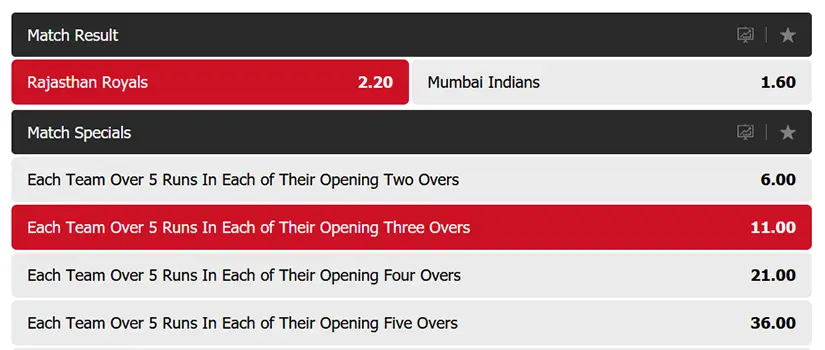
Team and Player Proposition Wagers in Cricket
Crickets is a complex sport and this complexity has paved the way for a huge number of proposition wagers. For clarification, a proposition (prop or novelty) bet has nothing to do with the outcome of a given game or series. These bets are more specific and harder to predict but they pay well if you do get them right. You can make them on individual batters or bowlers as well as on entire teams.
- The coin toss winner is a type of a team proposition bet where punters are trying to guess which side will win the coin toss at the beginning of the game. The captain of the side that wins the coin toss gets to decide whether his team will bat or bowl first. A coin toss is an even-chances proposition, but bookmakers typically assign 10/11 (1.91) odds on either side. Thus, the implied probability for one of the teams is slightly lower than 50%.
- The coin toss combination wager is somewhat of an extension of the coin toss bet. With this wager, the punter can also predict whether the team that wins the toss will choose to bowl or bat at the start of the match. You win provided that you predict both the toss winner and the captain’s decision (bat or bowl). As this wager is much harder to get right, it usually comes with higher odds at the expense of lower implied probability.
- Total fours is yet another team proposition wager that requires you to guess whether the overall number of fours scored by a team will be higher or lower than a specific benchmark. Fours are the four runs a batter gets when he or she sends the ball across the boundary line.
- The method of dismissal is a player proposition bet where the objective is to guess precisely how a batter on the crease will get eliminated. Such bets yield higher payouts but this comes at an expense since they are rather difficult to predict correctly. Method of dismissal wagers are normally available for in-play betting on games that are still in progress.
- With the top bowler wager, punters have to predict which player will take the greatest number of wickets. It is similar to the top batter bet where your objective is to guess the batter to score the most runs. Some online sportsbooks allow punters to adjust these bets by wagering on the top batter/bowler for a side or the entire match.
- Century to be scored in a match is another advanced proposition wager that is unsuitable for the faint of heart. The purpose here is to predict whether a batter will reach a score of a hundred or more runs within a single innings. Some bookies also take half-century bets on whether a batter will score fifty runs in one innings. Half-century bets are also known as “To score fifty runs”.
- Man of the match is also an option for more advanced punters. The title normally goes to the player with the greatest contribution to winning a given match. However, players from the losing side have also won the title in the past. You will encounter this wager type under different names as some bookies list it as “player of the match” or “player of the series”. Note that these awards are very common in test cricket.
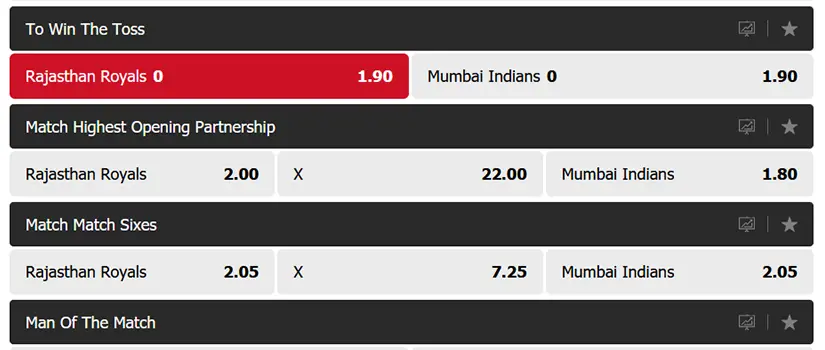
Live Betting in Cricket
Online sportsbooks enable cricket fans to live every bowl and run by offering them live streams of major cricket matches and series. Customers usually have the chance to punt on various in-play markets. Unlike pre-match markets, here you get to place your wager after a game has started. The prices for in-play bets update automatically as the matches unfold.
When oddsmakers see a cricket team is falling behind or leading, they will adjust the odds to reflect the changes. With in-play betting, an underdog can become a favorite oddswise, and vice versa. Another benefit of live betting on cricket is that it sometimes enables you to hedge your action. In turn, this might help to recover your losses or break even.
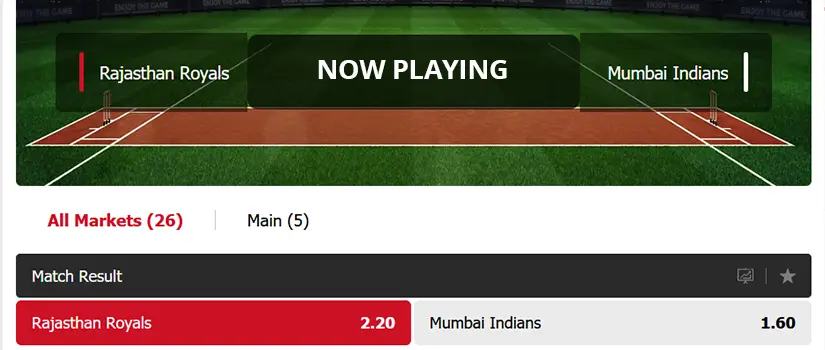
Cricket Betting Strategy and Tips
Being a successful cricket punter is no picnic. Getting there requires a good deal of commitment, persistence, time, and research. Betting on this complex sport is not for the unprepared, so our experts have put together several tips for you to follow if you are new to cricket. Hopefully, the paragraphs below will stand novices in good stead when they start their cricket betting careers.
- Study the cricket teams in advance. It is important to collect as much information as you possibly can, especially if you plan on betting on the in-play cricket markets. Make sure you check the starting lineups before a match commences. Do some research on the two sides’ batters, bowlers, and wicket keepers to see how they have performed lately or whether they have suffered recent injuries.
- Consider the weather conditions. Few other sports are influenced as much by the weather as cricket is. Cricket matches and series are hosted worldwide and weather conditions often vary depending on geographical location. The climate affects many aspects of the game including the surface of the cricket pitch.
The pitches in countries like New Zealand and Australia are usually greener due to the milder climate. By contrast, cricket pitches in places like India are usually dustier and drier. It is important to remember cricket teams are prone to deliver better performances when the game unfolds in familiar conditions, especially on home ground. - Do not underestimate the importance of the coin toss. Perhaps you will find it hard to believe that the toss of a simple coin has a major influence on how a cricket match plays out but it does. It helps determine which of the two sides gets to bowl or bat first.
The captains of teams with a more solid bowling lineup would naturally choose to bowl first so that their cricketers can take more wickets earlier in the game. And vice versa, teams with a higher batting potential would prefer to bat first and try to score more early runs. Note that weather and pitch conditions can also influence the captains’ decision after the coin toss. - Keep track of the statistics if you punt on the in-play markets. The best online sportsbooks out there cater to in-play bettors with live statistics, allowing them to stay on top of all cricket matches, domestic or international. Remember what we said earlier? Like baseball, cricket is all about statistics. So why not use the stats to your advantage if they are so readily available to you? Some sites even offer specialized software that can help you analyze all this information.
- Observe for ball changes. This particular tip is relevant mostly for test cricket but you can use it for one-day internationals and Twenty20 matches as well. The bowling teams in test games have the option to request a ball change after eighty overs. It makes sense that a ball that has been in play for hours gets well worn after all this batting.
Ball changes are important because new balls are normally thicker, harder, and bouncier. Worn-out balls usually work to the disadvantage of the bowling side since they do not deviate as much. Bowling teams often take many successive wickets once a new ball enters the game. We suggest you keep a tally on the overs so you can easily spot the ball change. This way you can take advantage of the in-play bowling markets at the right moment.
 Basic Rules
Basic Rules